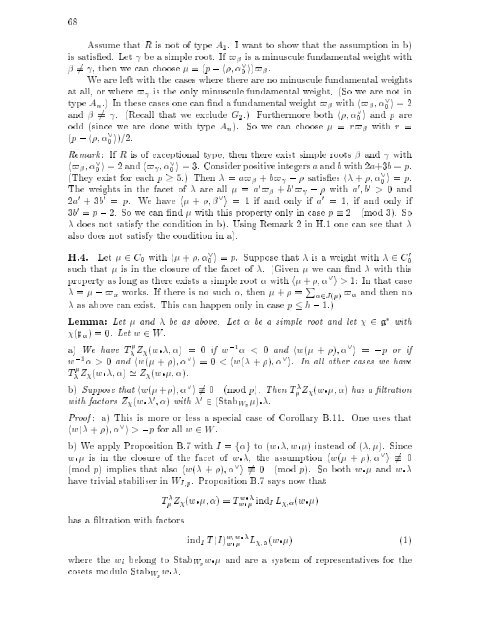subregular nilpotent representations of lie algebras in prime ...
subregular nilpotent representations of lie algebras in prime ...
subregular nilpotent representations of lie algebras in prime ...
Create successful ePaper yourself
Turn your PDF publications into a flip-book with our unique Google optimized e-Paper software.
68<br />
Assume that R is not <strong>of</strong> type A1. Iwant toshow that the assumption <strong>in</strong> b)<br />
is satis ed. Let be a simple root. If $ is a m<strong>in</strong>uscule fundamental weight with<br />
6= ,thenwe can choose =(p ,h ; _ 0 i)$ .<br />
We are left with the cases where there are no m<strong>in</strong>uscule fundamental weights<br />
at all, or where $ is the only m<strong>in</strong>uscule fundamental weight. (So we are not <strong>in</strong><br />
type An.) In these cases one can nd a fundamental weight $ with h$ ; _ 0 i =2<br />
and 6= . (Recall that we exclude G2.) Furthermore both h ; _ 0 i and p are<br />
odd (s<strong>in</strong>ce we are done with type An). So we can choose = r$ with r =<br />
(p ,h ; _<br />
0 i)=2.<br />
Remark: If R is <strong>of</strong> exceptional type, then there exist simple roots and with<br />
h$ ; _ 0 i = 2 and h$ ; _ 0 i = 3. Consider positive<strong>in</strong>tegers a and b with 2a+3b = p.<br />
(They exist for each p 5.) Then = a$ + b$ , satis es h + ; _ 0 i = p.<br />
The weights <strong>in</strong> the facet <strong>of</strong> are all = a 0 $ + b 0 $ , with a 0 ;b 0 > 0and<br />
2a 0 +3b 0 = p. We have h + ; _ i = 1 if and only if a 0 = 1, if and only if<br />
3b 0 = p , 2. So we can nd with this property only <strong>in</strong> case p 2 (mod 3). So<br />
does not satisfy the condition <strong>in</strong> b). Us<strong>in</strong>g Remark 2 <strong>in</strong> H.1 one can see that<br />
also does not satisfy the condition <strong>in</strong> a).<br />
H.4. Let 2 C0 with h + ; _ 0 i = p. Suppose that is a weight with 2 C 0 0<br />
such that is <strong>in</strong> the closure <strong>of</strong> the facet <strong>of</strong> . (Given we can nd with this<br />
property as long as there exists a simple root with h + ; _ = , $ works. If there is no such , then<br />
i > 1: In that case<br />
+ = P 2J( ) $ and then no<br />
as above can exist. This can happen only <strong>in</strong> case p h , 1.)<br />
Lemma: Let and be asabove. Let be a simple root and let 2 g with<br />
(p )=0. Let w 2 W .<br />
a) We have T Z (w ; ) = 0 if w ,1 < 0 and hw( + ); _ i = ,p or if<br />
w ,1 >0 and hw( + ); _ i =0< hw( + ); _ i. In all other cases we have<br />
T Z (w ; ) ' Z (w ; ).<br />
b) Suppose that hw( + ); _ i6 0 (mod p). Then T Z (w ; ) has a ltration<br />
with factors Z (w 0 ; ) with 0 2 (StabWp ) .<br />
Pro<strong>of</strong> : a) This is more or less a special case <strong>of</strong> Corollary B.11. One uses that<br />
hw( + ); _ i > ,p for all w 2 W .<br />
b) We apply Proposition B.7 with I = f g to (w ; w ) <strong>in</strong>stead <strong>of</strong> ( ; ). S<strong>in</strong>ce<br />
w is <strong>in</strong> the closure <strong>of</strong> the facet <strong>of</strong> w , the assumption hw( + ); _ i 6 0<br />
(mod p) imp<strong>lie</strong>s that also hw( + ); _ i6 0 (mod p). So both w and w<br />
have trivial stabiliser <strong>in</strong> WI;p. Proposition B.7 says now that<br />
has a ltration with factors<br />
T Z (w ; )=T w<br />
w <strong>in</strong>dI L ; (w )<br />
<strong>in</strong>dI T (I) wiw<br />
w L ; (w ) (1)<br />
where the wi belong to StabWpw and are a system <strong>of</strong> representatives for the<br />
cosets modulo StabWpw .

















